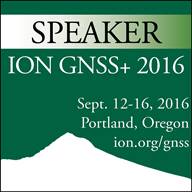Care to join me at ION GNSS+ 2016?
31 Aug 2016ION GNSS+ 2016
This September I will be attending ION GNSS+ 2016, taking place September 12-16 at the Portland Convention Center in Portland, Oregon.
ION GNSS+ 2016 is the world’s largest technical conference focusion of different means of navigation. This is where a new GNSS and navigation technologies are showcased and discussed for the first time. This year is special as ION will be celebrating 30 years of ION conferences (changing name from ION GPS through ION GNSS to ION GNSS+, showing the growth of importance of other constellations and navigation sensors such as IMS or Locata1). This will involve 1980’s style celebration, featuring the decade’s best food, games, and music.

My paper
I will be presenting in the Session F3: Marine Applications on Thursday, September 15 and discussing University of Nottingham and the Royal Norwegian Naval Academy joined research in the jamming of the GPS signal.
Why would this be important?
Ship traffic has increased fourfold over last 25 years and now constitute 90% of global trade by volume. Analysis of accidents and serious incidents worldwide indicate that half of them are due to the navigational error. This ratio has significantly increased in period 1995-2002, concurrent with the introduction of easy to use electronic chart Displays (ECDIS) and GPS navigation. Recent reports has also identified the lack of other systems knowledge across the crew.
This all suggest the navigators’ over-reliance on the GPS.
GPS, due to its signal strength, can be reasonably easily jammed using so-called privacy devices - small and low powered GPS jammers, mostly under $50, used to prevent tracking of goods or vehicles. Those are illegal in USA and Europe, but enforcing this remains tricky. Our previous research shown that the typical maritime GPS receiver is easy to jam and may produce visibly erroneous positional information up to 600 meters from standard GPS L1 jammer and complete loss of signal within 200 meter radius.
This creates an opportunity for very difficult to detect and prevent cyber-attack, which can lead to a serious maritime incidents, especially in poor visibility.

Interested in learning more?
I will be presenting my recent results on Thursday, September 15. If you would like to join me and the others in Portland, register here.
-
Locata is a novel positioning technology from Australia based on the concept of Pseudolites, that is static, earthbound transmitter utilising GPS signal structure and sometimes even frequency. What is really interesting with this technology is its very precise network synchronisation, using technology called Timeloc and its use of WiFi frequency. I think the most impressive use of the technology is its deployment on the White Sands Missile Range (WSMR) in New Mexico, USA. If you want to learn more, my PhD thesis might be of use. ↩